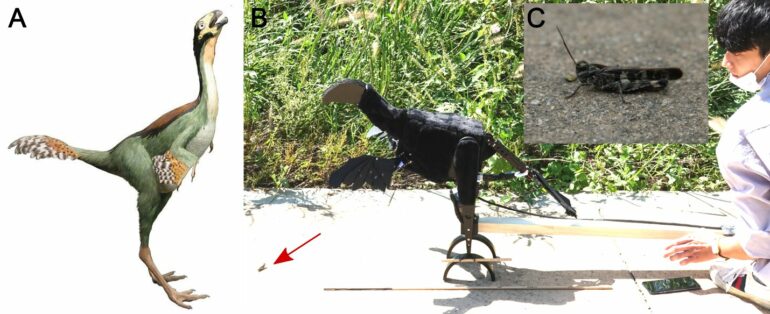What are the origins of wings and tails in birds? This is one of the key questions in the evolution of animals. It has long been accepted that their evolution began in feathered dinosaurs.
Some of these dinosaurs had feathers on the tails and small wing-like feathers on their forelimbs. These small wing-like structures called ‘proto-wings’ are composed of special feathers known as pennaceous feathers—the stiff feathers found in the wings and tails of birds.
The ancient form of these feathers first emerged in dinosaurs during the Jurassic Period, and these dinosaurs, called Pennaraptorans, had proto-wings made of pennaceous feathers. However, it has been known that these proto-wings were too small for powered flight. Because we cannot time-travel to observe their behavior, what dinosaurs did and how they behaved remains unanswered.
Various functions of proto-wings and tail feathers in the ancestors of birds have been considered since John Harold Ostrom proposed the first idea 50 years ago that proto-wings were used to knock down insect prey by small predatory dinosaurs living on the ground and following their prey. However, how the small ‘proto-wings’ and feathered tails helped the dinosaurian ancestors of birds in their lives has not been resolved.
A new scientific collaboration involving a team of field-biologists and integrative ecologists (Piotr G. Jablonski, Sang-im Lee, Jinseok Park, Sang Yun Bang, and Jungmoon Ha), paleontologists (Yuong-Nam Lee and Minyoung Son), and roboticists (Hyungpil Moon and Jeongyeol Park), has proposed a new idea: the ‘flush-pursue hypothesis.’ Their paper was published in Scientific Reports.
The name of the hypothesis provides a clue to its content. Some birds employ a ‘flush-pursue’ foraging strategy, using wings and/or tail displays to visually flush out hiding prey and pursue the flushed prey (e.g., Northern Mockingbird, Linzy’s Vids). The hypothesis suggests that small dinosaurs with proto-wings use a similar strategy.
The hypothesis is rooted in years of detailed field-ornithological studies on several species of insectivorous birds conducted by a co-author of the current study, Piotr Jablonski and collaborators, as well as by Ron Mumme and collaborators [for example, the Painted redstart, the Slate-throated whitestart, the Spectacled Whitestart, and the Hooded warbler].
Studies on these birds have revealed that displaying contrasting plumage (often with black-and-white patches) on the wings and tails triggers the escapes of their prey and thus increases bird foraging efficiency because the escaping prey is pursued and caught by the birds.
Neurobiology behind this relationship was also studied. It has been proposed by Piotr Jablonski and Nicholas Strausfeld, a leading expert in arthropod’s nervous system, that special neurons in insects are activated by simple properties of flush displays by insectivorous flush-pursuing birds.
Piotr Jablonski with collaborators first mentioned the flush-pursue hypothesis at the 2005 Gordon Research Conference on ‘Neuroethology: Behavior, Evolution and Neurobiology’ chaired by N. Strausfeld. Since then, the idea was developed and presented at 2018 International Ornithological Congress, and at the Society for Integrative Biology Annual Meeting 2023.
“After conducting extensive field studies on birds and delving into the examination of neurons in their prey, I have unsuccessfully tried for years to convince funding organizations and skeptical grant reviewers in Poland, U.S. and Korea to support studies evaluating this hypothesis concerning early pennaraptoran dinosaurs,” comments field-ornithologist Piotr Jablonski.
“Eventually, the funding provided by Seoul National University allowed us to initiate our collaborative research and complete it with some additional funding. Finally, after facing multiple refusals from the Editorial Boards of 11 journals, each denying approval for a standard peer-review process of the paper, we finally found a journal that allowed our results to be peer-reviewed, which led to its publication,” adds Piotr Jablonski.
“We have chosen Caudipteryx as a representative of early Pennaraptoran dinosaurs,” explains paleontologist Yuong-Nam Lee, a specialist in dinosaur fossils and a co-author of the study.
The robotics team led by Hyungpil Moon, an expert in robotics, has constructed a robot named ‘Robopteryx,’ that resembles the morphology of Caudipteryx. Simultaneously, the biology team has conducted a comprehensive review of the diversity of wing and tail displays used by existing flush-pursuing birds to trigger escapes in their prey visually.
The researchers compiled links to clips illustrating this diversity among birds (see supplementary materials in their paper, and some other links to examples provided below).
Equipped with nine motors, ‘Robopteryx’ was programmed to imitate the movements of forelimbs and tail of ground-foraging flush-pursuing birds, such as the greater roadrunner (Kat Avila) or the rufous-tailed scrub robin (Nature Never Die), within the anatomical constraints determined from paleontological literature by Minyoung Son, an expert in the anatomy of Cretaceous dinosaurs.
Jinseok Park (the first author of the paper and a field-ornithologist focusing on avian diet and foraging), with a team of field-biologists, conducted tests with ‘Robopteryx’ to observe behavioral responses of wild grasshoppers, which belong to the ancient order Orthoptera likely to co-occur with pennaraptoran dinosaurs.
The results revealed that grasshoppers escaped more frequently when proto-wings were present on the forelimbs, compared to displays without proto-wings. Additionally, grasshoppers fled more often when the proto-wings had white patches, compared to when they were plain black. Moreover, grasshoppers escaped more frequently when tail feathers were present, particularly when the area of tail feathers was large.
Since the reactions of simple neural circuits involved in escapes in insect prey are crucial for understanding the evolution of flush-pursuing strategy in birds, the researchers decided to compare the responses of neurons of grasshoppers to the hypothetical displays by the dinosaurs.
“I created computer animations (examples in the supplementary materials of the paper) imitating the hypothetical displays by Caudipteryx and presented them to grasshoppers in the laboratory,” explains Jinseok Park.
“I used easily available inexpensive equipment to record responses of neurons,” Jinseok adds. The researchers found that the reactions of neurons, particularly peak firing rates, were higher in response to the animations with proto-wings than those without.
Based on the results, the researchers argue that dinosaurs’ prey would have been more likely to flee when proto‑wings made of feathers were present, especially near the end of the forelimbs and with contrasting patterns, and when the tail feathers, especially of a large area, were used during hypothetical flush‑displays.
“We propose that using plumage to flush prey could increase the frequency of chases after escaping prey, thus amplifying the importance of proto-wings and tails in maneuvering for successful pursuit. This could lead to the development of larger and stiffer feathers as these would enable more successful pursuits and more pronounced visual flush-displays,” summarizes Sang-im Lee, the integrative ecologist member of the research team, who earlier studied the role of avian alula in aerial maneuvers by flying birds.
More information:
Jinseok Park, Escape behaviors in prey and the evolution of pennaceous plumage in dinosaurs, Scientific Reports (2024). DOI: 10.1038/s41598-023-50225-x. www.nature.com/articles/s41598-023-50225-x
Provided by
Seoul National University
Citation:
Dinosaurs might have used feathers on forelimbs and tails to flush and pursue their prey, say biologists (2024, January 25)



